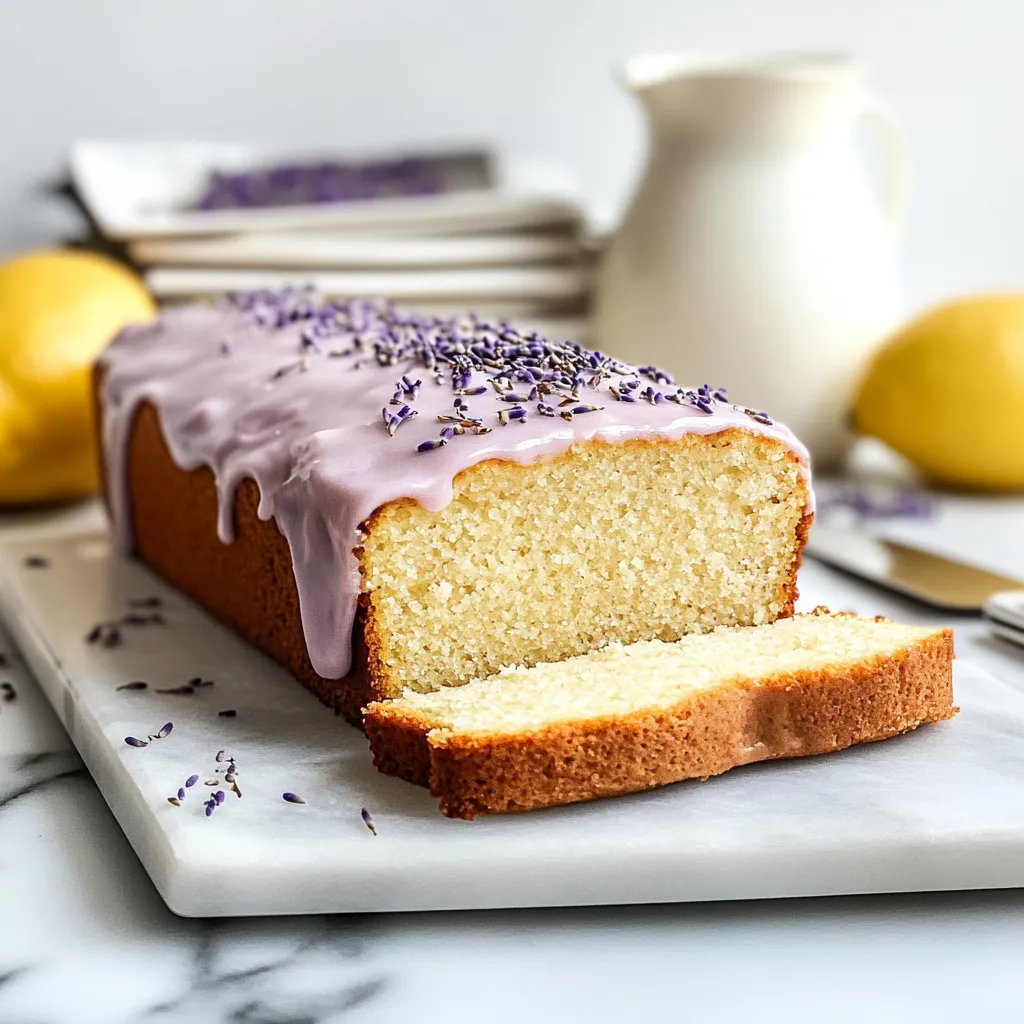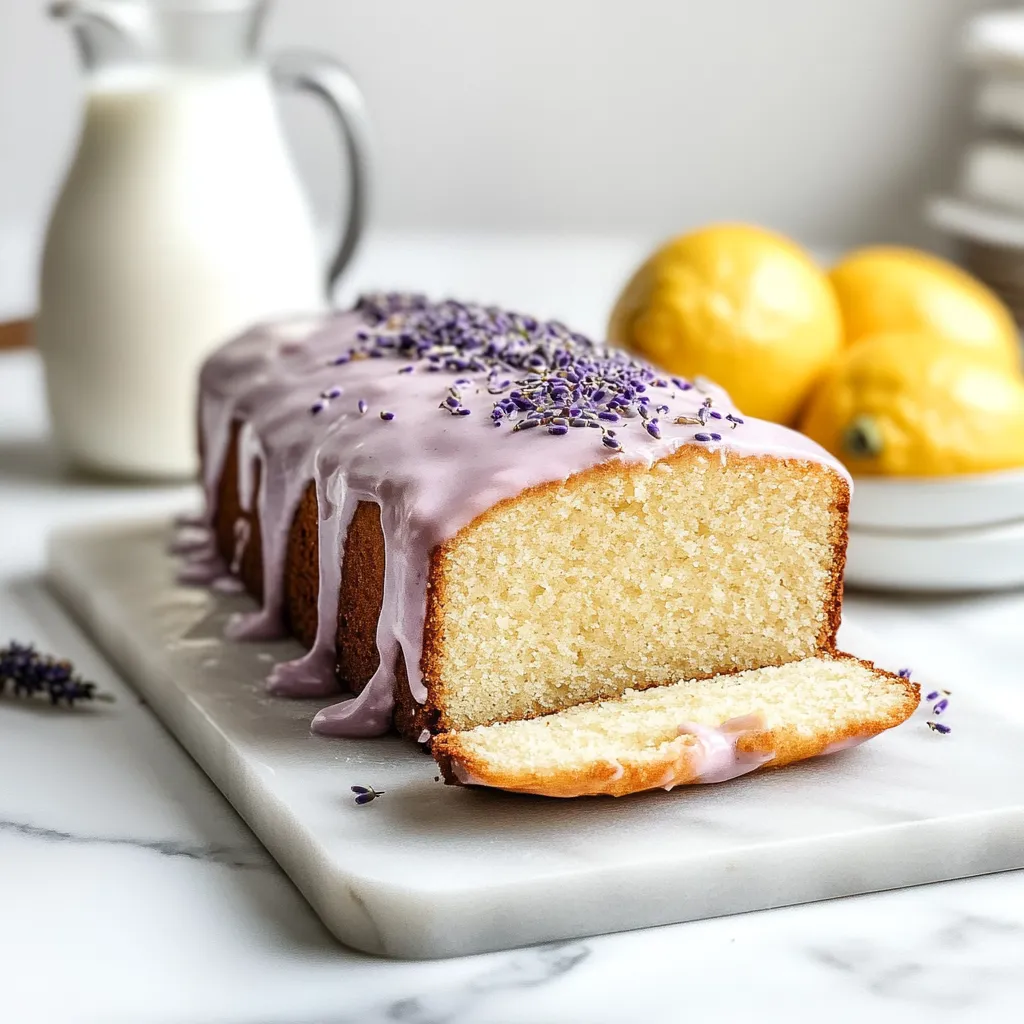 Pin
Pin
Every bite of this Lemon Lavender Loaf is seriously like biting into a slice of spring. Super zesty lemon pairs with a gentle touch of floral lavender that comes through without feeling over-the-top. You get fresh lemon zest scrubbed with sugar for max flavor, loads of bright, tangy juice, and the lavender gets steeped in warm oil to unlock its prettiest notes. All these steps together give you a soft, moist loaf with flavors that play off each other instead of competing. You’ll notice that sunny pop of lemon first, then a chilling-out, floral finish that lingers just enough. There’s nothing plain about this—it’s next-level citrus goodness, but still comforting and down-to-earth.
This came together while I was daydreaming about the lemon trees and lavender that used to fill my grandma’s backyard. First time I shared it at a spring hang, everyone stopped talking the second they tasted it, just trying to figure out what that lovely flavor was behind the lemon. Before the desserts were cleared, three friends wanted the how-to, and even my brother-in-law—who runs from "bougie" sweets—asked for this as his birthday pick. Ever since, it’s my signature spring-summer bake that always kicks off those fun, surprised grins after the first bite.
Dreamy Ingredients
- Greek yogurt (⅓ cup): Makes each bite super moist and gives a slight tang that boosts the lemon
- Salt (½ teaspoon): Brings out all the flavors and keeps it from being too sugary
- Baking powder (2 teaspoons): Gives your cake that fluffy lift
- All-purpose flour (1¾ cups): The strong base for the loaf’s soft-but-structured crumb
- Vanilla extract (1 teaspoon): Blends all the tastes with a warm background
- Large eggs (3): Hold it together and bring real richness
- Granulated sugar (1 cup): Sweetens and helps get all the oils out of the lemon zest
- Lemons (3 medium): Zest and juice bring the fresh, bold citrus character
- Canola oil (½ cup): Keeps things ultra-moist and lets the lavender shine after steeping
- Culinary lavender (2 tablespoons): Adds a gentle but unmistakably floral twist
Loaf Magic
Lavender Steeping
Start by pulling out the best flavors: blooming the lavender. Pour canola oil in a saucepan and let it warm up over medium-high for about one minute—just till it feels hot (don’t let it smoke). Take the pot off the burner, toss in the lavender, then slap a lid on fast to trap the heat. Let it hang out for half an hour at least, even longer if you want bigger flavor. You’ll notice a faint purple color and a lovely scent. Strain the oil through a mesh sieve, pressing down to squeeze out all that lavender goodness.
Lemon Power-Up
As your lavender is steeping, work on the lemons for big flavor. Carefully zest all three, making sure not to go too deep and scrape up bitter white parts. Dump the zest over your sugar, then use your fingers to mash and rub it all together until the sugar gets pale yellow and smells like crazy lemon. This trick releases the oils and cranks up the freshness. When you’re done, juice those now-naked lemons to grab all the tartness they’ve got.
Lift and Lightness
Grab a stand mixer with the whisk and beat those eggs together with the lemon-sugar mix and vanilla extract. Crank it up high for about 3-4 minutes. Yes, it’s a while, but trust—it needs that time to whip up. Watch the mixture triple in size, turning light yellow and super fluffy. It should run off the whisk in thick ribbons and look pretty airy—that’s the secret to the soft texture you’ll get out of the oven.
Easy Oil Blend
With your mixer running on medium, slowly pour that lavender oil in a thin stream so you don't lose all that air you whipped in. Blend until it looks fully mixed and shiny, no pools of oil left. Give it another 30 seconds on medium for smooth sailing. At this point your batter should look glossy and pull together nicely.
Dry Meets Wet
In a new bowl, stir the flour, baking powder, and salt. Scoop a third of this mix into your wet batter, then mix on low till just blended—don’t overdo it. Add half the yogurt and lemon juice, give it a little mix, then keep switching between dry and wet, ending with the last third of dry. You’ll end up with a batter that pours but isn’t runny, kinda like thick pancake mix. Mixing this way helps everything stay light and keeps air in the batter.
Chill Baking
Pour your batter into a parchment-lined, well-oiled 9x5 loaf pan, making sure the parchment goes up the long sides for easy removal. Bake at 350°F for around 45-50 minutes—poke with a toothpick and you should just see a few moist crumbs come out, not raw batter. The loaf’s top should look golden and bounce back a bit when you press it. This slower bake helps the loaf rise evenly and keeps it from cracking or doming like crazy.
Waiting Game
Let your loaf cool off in the pan for 10 minutes—don’t rush or wait too long. Too soon and it might fall apart, but leave it too long and the bottom might get soggy. Use your parchment flaps to lift it out onto a rack. Now let it hang out until it’s not warm anymore, maybe up to two hours. Honestly, this patience is worth it. Wait for the cake to cool before you glaze, or the glaze will soak right in instead of sitting pretty on top.
 Pin
Pin
My grandma always told me flowers in bakes needed a gentle approach and lots of patience. “If you go heavy-handed, it’ll just taste like soap. Too little—what’s the point?” she’d joke with me while we snipped lavender in her backyard. This loaf gets it just right. The lavender plays backup to the lemon, not showboating, and makes me think of those sunny kitchen days learning from her. Blending garden favorites the careful way, that’s where magic happens. The best flavors don’t always come from wild combos—they just need the right touch, and a little respect for the ingredients doing their thing.
Fun Ways to Serve
Slice it thin and set it out with a spoonful of soft whipped cream or a bit of crème fraîche on the side. If you’re pouring tea, go for light, floral ones like Earl Grey or white tea so nothing drowns out the loaf’s flavor. Happen to have berries? Toss them on for color and flavor. Want to up the dessert vibes? Warm up a piece, top it with a scoop of vanilla ice cream, and let it melt into the cake for an amazing treat with a cool, creamy finish next to that pop of citrus and lavender.
Mix It Up
Switch things around with just a few tweaks. Ditch the lavender and swap in chopped thyme or rosemary for a herby twist that still works with lemon. For a cool-weather treat, use orange instead of lemon and shake in some cardamom instead of lavender for a spiced twist. Special occasion? Stir in some fresh blueberries right before baking for juicy pops throughout. Want simple comfort? Leave out the lavender, double the vanilla, and you’ve got a rich lemon-vanilla loaf instead.
Keeping It Fresh
Store this loaf covered tightly at room temp and it stays moist for up to four days. Actually, the floral flavor comes through more the next day. For long-term stashing, wrap single pieces in plastic wrap and freeze for up to three months. To serve, just let a wrapped slice sit out for an hour. If your loaf is glazed, eat it in a couple of days for the best look (though the taste will still rock)—the glaze sometimes starts to sink in over time.
I’ve tried out a bunch of loaf bakes over the years, but this lemon-lavender combo is a definite highlight—familiar but just a little wild. Watching friends try it and figure out “what’s that extra flavor?” is a total joy. Even if the steps feel a little extra, every one really does matter for the result. Sometimes, pure kitchen magic isn’t about fancy looks or rare ingredients. It’s in taking a little care and letting simple things really pop together in the best way.
 Pin
Pin
Recipe Questions & Answers
- → What exactly is culinary lavender and how can I get some?
- Culinary lavender's just the kind you cook or bake with. It's way milder than regular garden lavender. Look for it in fancy stores, at local markets, or just buy online. Double-check that the package says 'culinary' or 'food grade.'
- → Is it okay to use dried lavender instead of fresh here?
- Yep, that's fine. Just remember dried lavender is stronger, so you'll only need about a third as much. So, if you need 1 tablespoon fresh, put in 1 teaspoon dried.
- → How do I make sure the loaf doesn’t end up super dense?
- Don't go crazy mixing after the flour's in. Measure the flour by spooning it in gently, not by scooping it. And bring everything to room temp first before you start. That really helps.
- → Do I need a big stand mixer for this loaf?
- Nope! A hand mixer or even just a whisk will absolutely get the job done. Just beat the eggs and sugar together really well till they're super pale and fluffy before you toss in the rest.
- → How can I tell when my loaf’s ready to come out of the oven?
- Stick in a toothpick—if it pops out clean or with just a few soft crumbs, you're good. The loaf should gently spring back if you press it, and it'll just start pulling away from the pan's sides.
